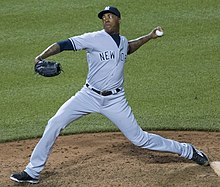In baseball statistics, strikeouts per nine innings pitched (abbreviated K/9, SO/9, or SO/9IP) is the mean of strikeouts (or Ks) by a pitcher per nine innings pitched. It is determined by multiplying the number of strikeouts by nine, and dividing by the number of innings pitched.
Leaders in Major League Baseball

The all-time Major League Baseball (MLB) career leader (minimum of 1,000 innings pitched) in this statistic through 2022 is Chris Sale (11.06). The only other pitchers who had averaged over 10 K/9 are: Robbie Ray (11.03), Jacob deGrom (10.96), Yu Darvish (10.70), Max Scherzer (10.69), Randy Johnson (10.61), Stephen Strasburg (10.55), Gerrit Cole (10.45), Kerry Wood (10.32), Pedro Martinez (10.04) and Aaron Nola (10.02).
The top three during the 2022 season were Carlos Rodon (11.98), Shohei Ohtani (11.87), and Gerrit Cole (11.53).
The career leader in K/9 among MLB relievers (minimum of either 300 innings pitched or 200 appearances) through 2020 was Aroldis Chapman (14.88), followed by Craig Kimbrel (14.66), Kenley Jansen (13.25), Rob Dibble (12.17), David Robertson (11.93), and Billy Wagner (11.92).
In 2022, Kyle Harrison led Minor League Baseball with 14.8 strikeouts per 9 innings, the highest rate for a pitcher in the minor leagues in a season (minimum of 100 innings pitched) dating back to 1960.
Analysis
One effect of K/9 is that it may reward or "inflate" the numbers for pitchers with high batting averages on balls in play (BABIP). Two pitchers may have the same K/9 rates despite striking out a different percentage of batters since one pitcher will pitch to more batters to obtain the same cumulative number of strikeouts. For example, a pitcher who strikes out one batter in an inning, but also gives up a walk or a hit, strikes out a lower percentage of batters than a pitcher who strikes out one batter in an inning without allowing a baserunner, but both have the same K/9.
References
- "K/9IP All Time Leaders". Baseball-Reference.com.
- "Year-by-Year Top-Tens Leaders & Records for Strikeouts per 9 IP". Baseball-Reference.com.
- "K/9IP leaders, minimum 200 appearances". Baseball-Reference.com.
- "K/9IP leaders, minimum 300 innings pitched". Baseball-Reference.com.
- "Rob Dibble Statistics". Baseball-Reference.com.
- "Top Pitching Prospects | Left-Handed". MLB.com.
- "Kyle Harrison Stats, Fantasy & News". MLB.com.
- James Gentile (October 8, 2012). "Stop using K/9 and BB/9!". Beyond the Box Score. SBNation.com.
This baseball-related article is a stub. You can help Misplaced Pages by expanding it. |
